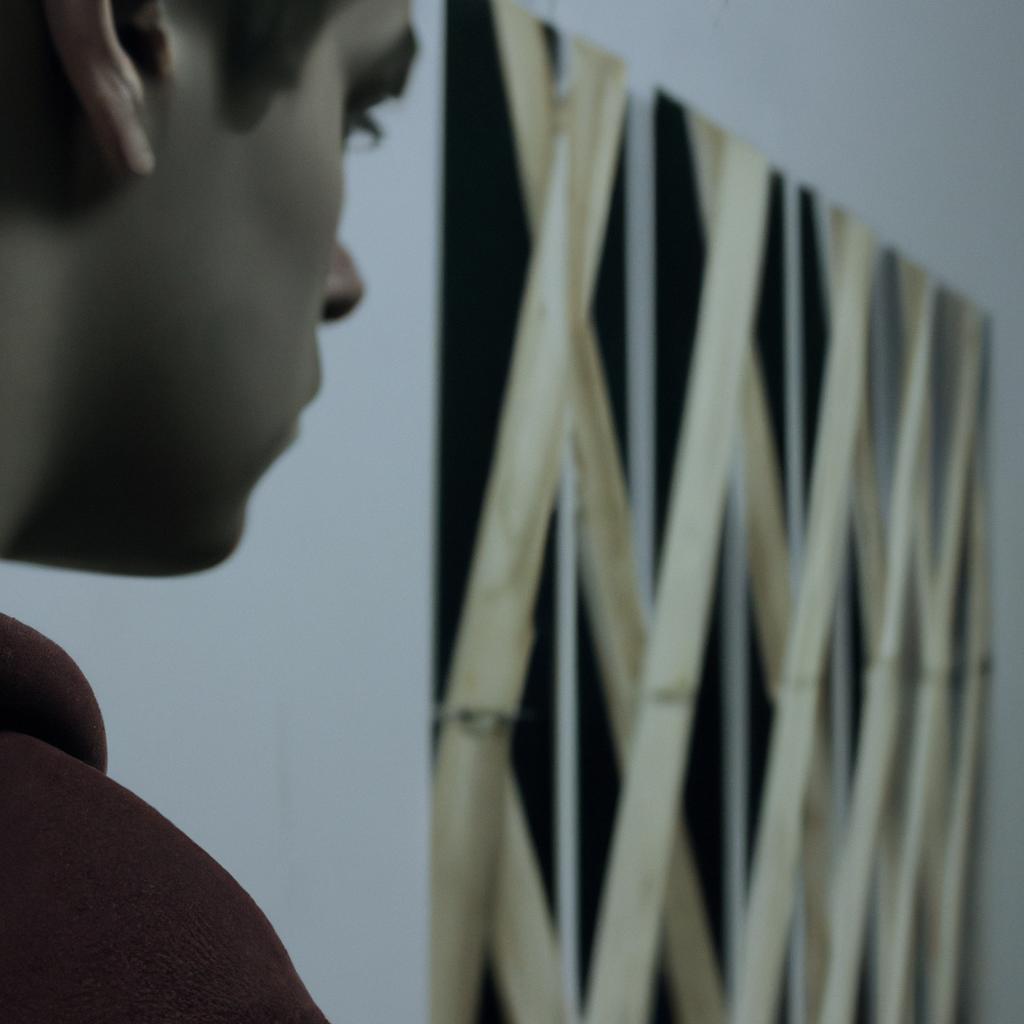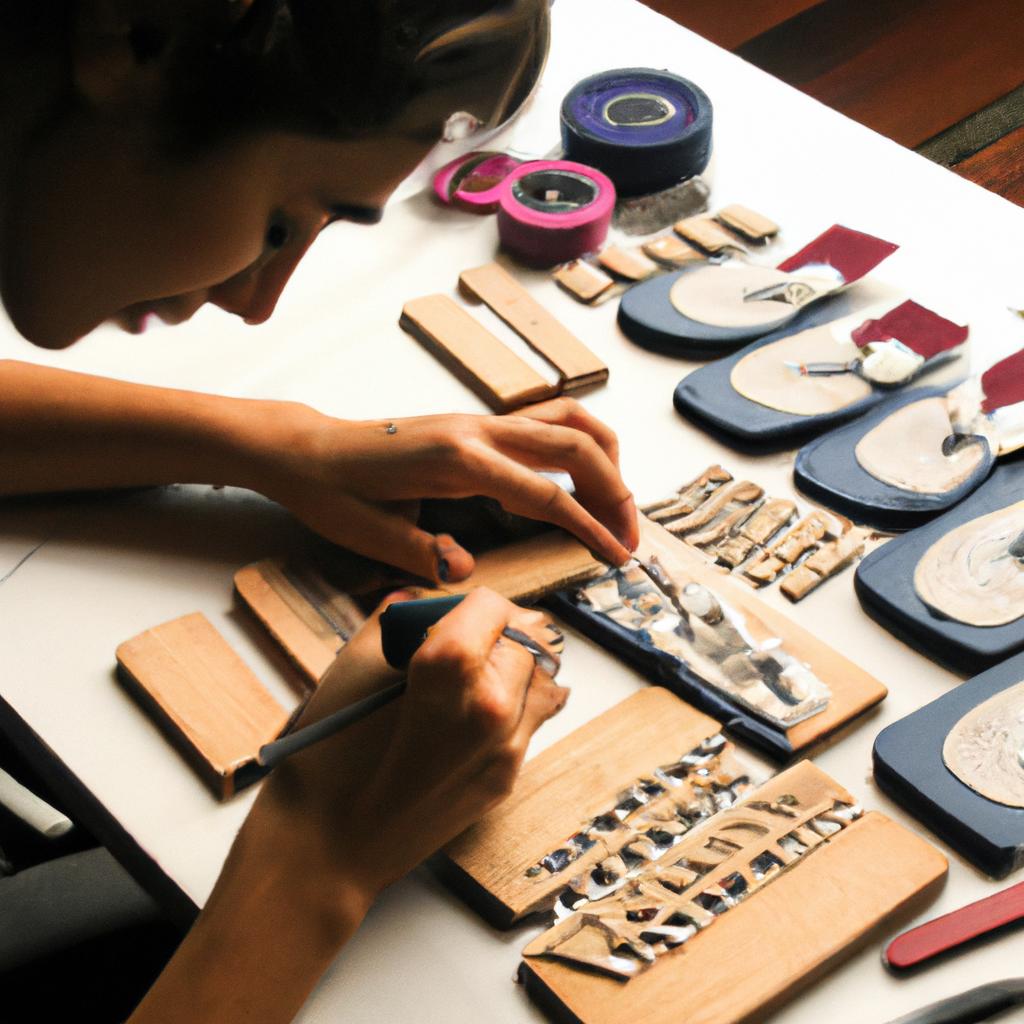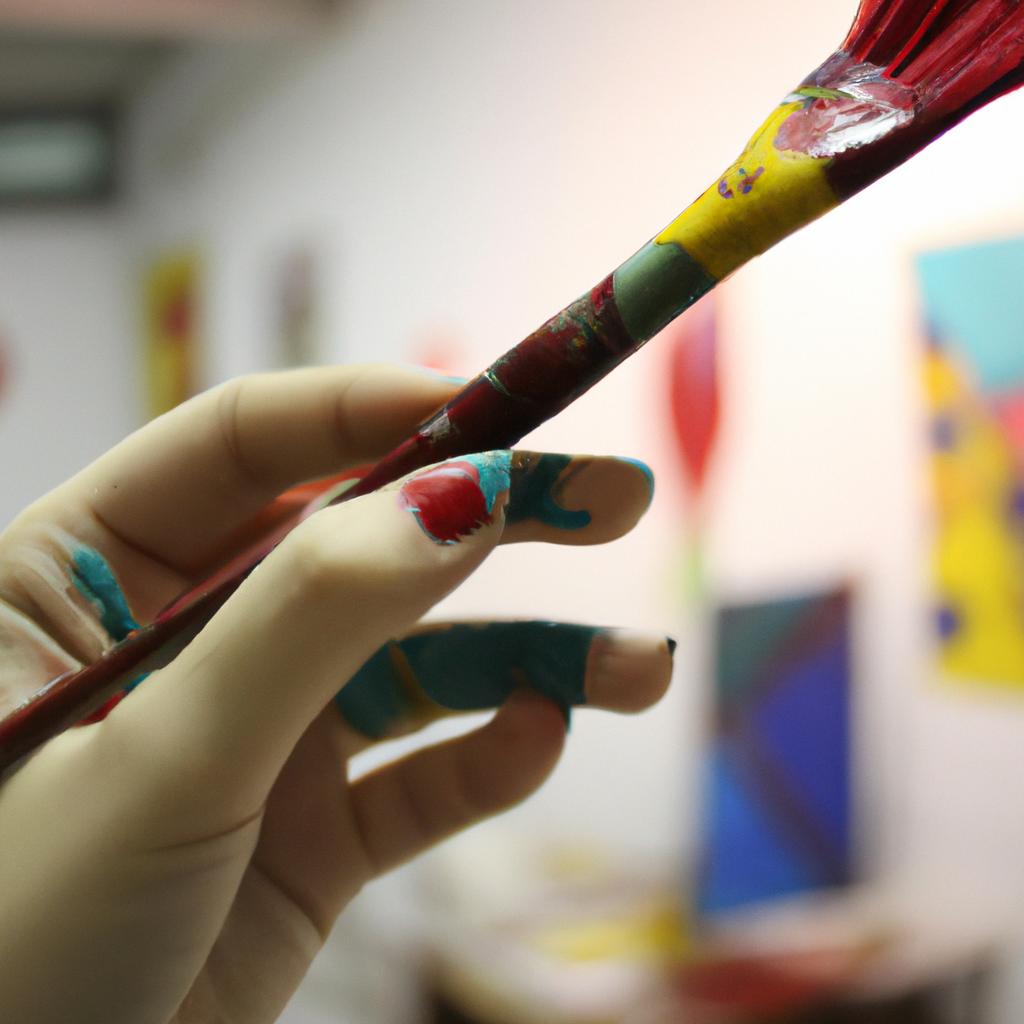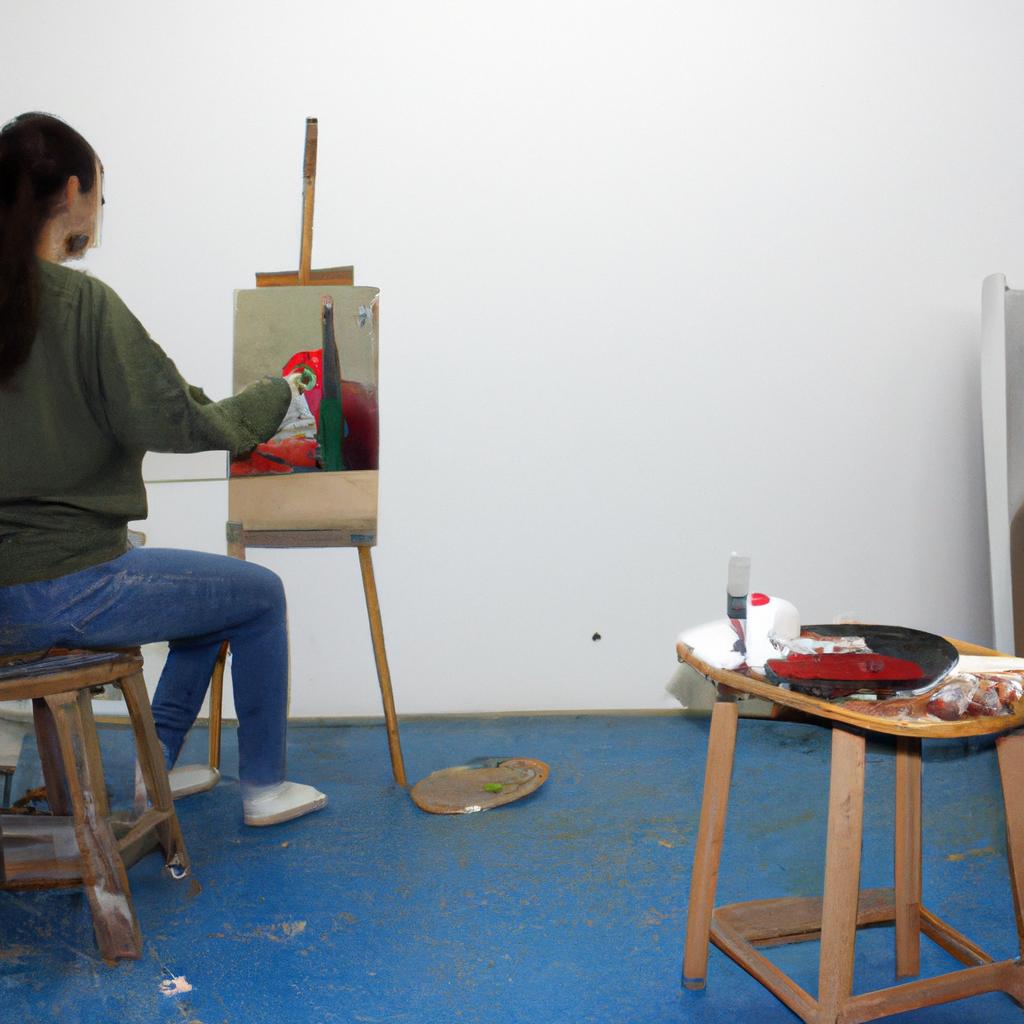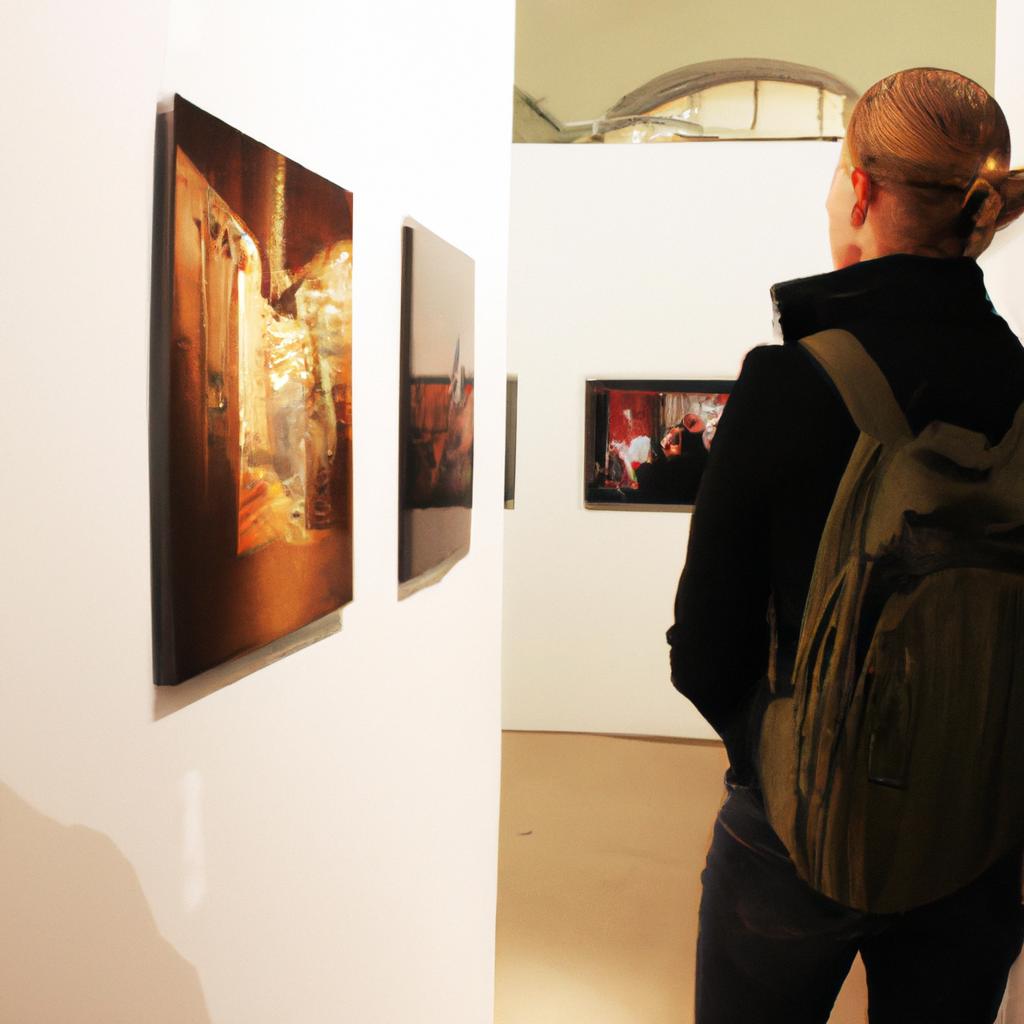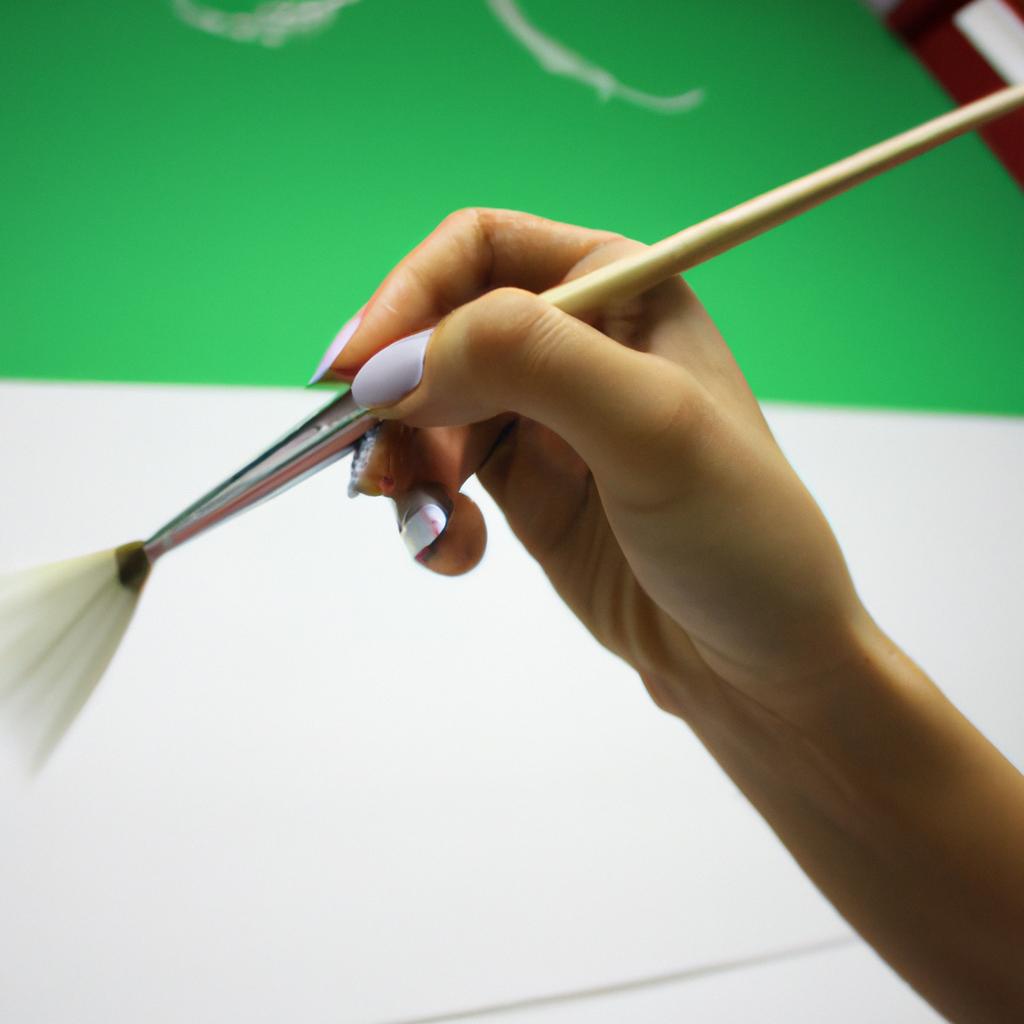Artistic Loans: Visual Arts in the Context of Borrowed Inspiration
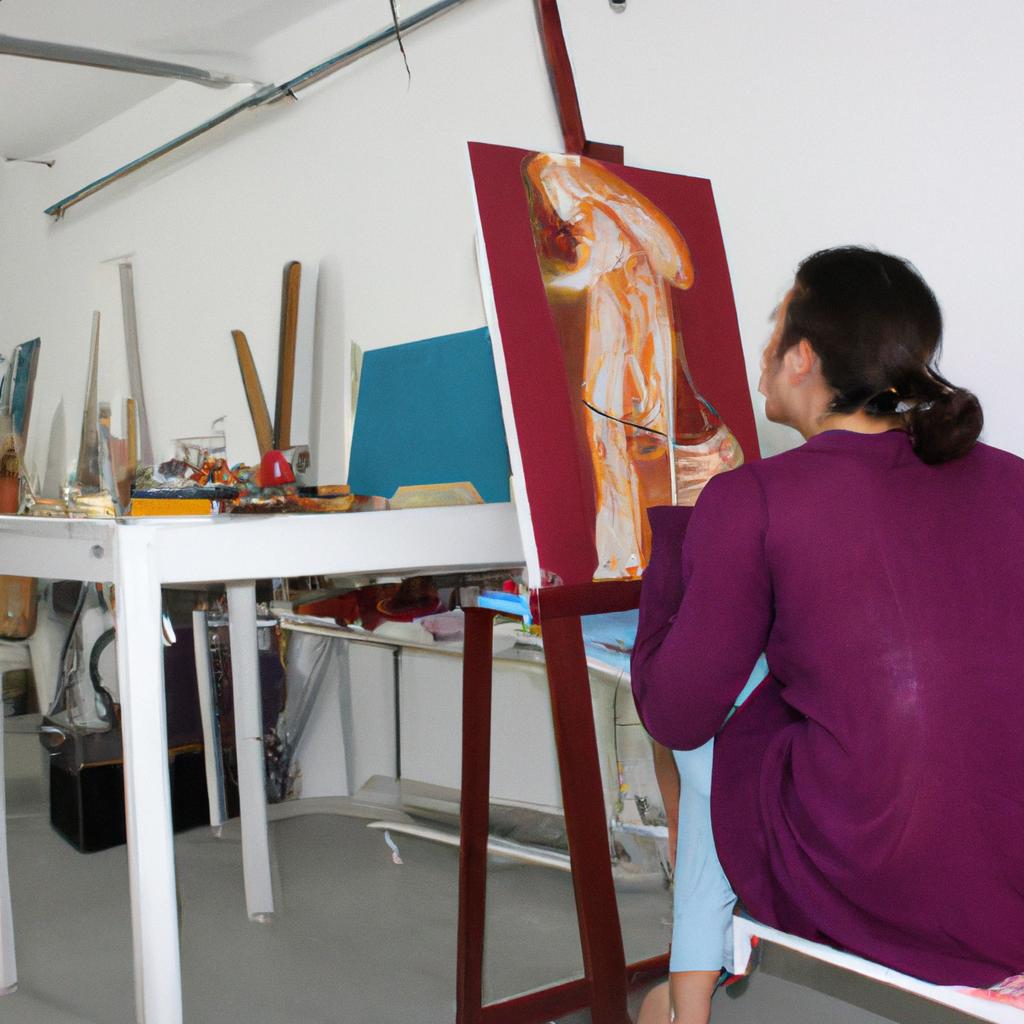
Artistic creation is often viewed as a solitary endeavor, with artists relying solely on their own creativity and imagination. However, this perception overlooks the significant influence that borrowed inspiration can have on an artist’s work. In the context of visual arts, the concept of artistic loans refers to the practice of incorporating elements from other artworks or styles into one’s own creative process. This article explores the intricate relationship between borrowing and innovation within the realm of visual arts, examining how artists throughout history have drawn upon external sources for inspiration.
One compelling example of artistic loans can be found in the works of Vincent van Gogh. Van Gogh was deeply influenced by Japanese woodblock prints during his time in Paris in the late 19th century. Fascinated by their bold colors and unique compositions, he began incorporating similar techniques into his own paintings. The result was a striking fusion of Eastern and Western artistic traditions, evident in iconic pieces such as “The Bridge at Arles” and “Starry Night.” By borrowing from Japanese art, van Gogh not only expanded his creative repertoire but also brought forth a new aesthetic vision that would later inspire countless artists around the world.
While some may argue that borrowing ideas or techniques from others diminishes originality, it is essential to recognize that artistic loans can actually enhance innovation and creativity. By engaging with different artistic traditions and incorporating elements from other artworks, artists can push the boundaries of their own practice and explore new possibilities. Borrowing, in this sense, becomes a means of expanding one’s artistic language and developing a unique voice.
Moreover, artistic loans are not limited to specific styles or movements but can encompass a wide range of influences. Artists may draw inspiration from historical art periods, cultural traditions, nature, literature, music, or even everyday life experiences. These borrowed elements serve as building blocks that artists manipulate and transform to create something entirely new.
In addition to providing fresh perspectives and ideas, borrowing can also function as a homage or tribute to the artists who came before. It is common for artists to pay homage to their predecessors by referencing iconic works or incorporating recognizable motifs into their own creations. This interplay between past and present creates a rich dialogue between artists across time periods and fosters a sense of continuity within the art world.
Ultimately, the act of borrowing in art is not about replication or imitation but rather about reinterpretation and innovation. It is about taking inspiration from various sources and infusing them with one’s own unique perspective and creative vision. The result is an ever-evolving artistic landscape where ideas flow freely, influencing each other in an ongoing exchange of inspiration.
So while artistic creation may often be seen as solitary, it is important to acknowledge the significant role that borrowed inspiration plays in shaping an artist’s work. By embracing diverse influences and engaging in Artistic Loans, artists can continue to push boundaries, challenge conventions, and contribute to the ongoing evolution of visual arts.
The Power of Collaboration
Collaboration in the realm of visual arts has long been recognized as a catalyst for creative growth and innovation. When artists come together, sharing their ideas, skills, and perspectives, they tap into a powerful source of inspiration that can propel their artistic endeavors to new heights. This section explores the significance of collaboration within the context of artistic loans – borrowing inspiration from others.
One compelling example that demonstrates the power of collaboration is the case study of renowned painter Pablo Picasso and sculptor Julio González. In the early 20th century, these two artists joined forces to collaborate on various projects, combining Picasso’s abstract paintings with González’s innovative metal sculptures. Their partnership resulted in groundbreaking works such as “Woman in Green” (1932), where Picasso’s vibrant brushstrokes interact harmoniously with González’s welded iron figures. Through this collaborative effort, both artists expanded their artistic boundaries and redefined traditional notions of painting and sculpture.
To evoke an emotional response from our audience, we present four key aspects that highlight the transformative nature of collaboration:
- Mutual Inspiration: Collaborators inspire each other through shared visions and complementary strengths.
- Cross-Pollination: Different artistic disciplines merge seamlessly, creating dynamic hybrid artworks.
- Creative Fruition: Collaborative efforts often lead to accelerated development and realization of artistic concepts.
- Collective Support: Working together fosters a supportive environment that encourages risk-taking and experimentation.
Furthermore, let us consider a table illustrating how collaborations can yield remarkable outcomes:
| Artist A | Artist B | Resulting Artwork |
|---|---|---|
| Photographer | Poet | Inspirational photo-poem anthology |
| Dancer | Musician | Captivating dance performance |
| Filmmaker | Composer | Emotionally charged film score |
| Fashion Designer | Visual artist | Avant-garde fashion exhibition |
In conclusion, collaboration in the context of artistic loans provides artists with a platform to exchange ideas, push boundaries, and collectively create something greater than the sum of its parts. By harnessing the power of collaboration, artists can explore new dimensions within their practice and make meaningful contributions to the ever-evolving world of visual arts.
Transitioning into the subsequent section about “Exploring New Spaces,” we delve deeper into how collaborations enable artists to step outside traditional creative confines and embrace uncharted territories.
Exploring New Spaces
Previous section H2 (The Power of Collaboration)
Building upon the power of collaboration, this section delves into exploring new spaces that broaden artistic horizons and foster creative growth.
To fully embrace borrowed inspiration, artists must venture beyond their comfort zones and explore uncharted territories. One such example is an artist who traditionally works with oil paintings deciding to experiment with mixed media installations. By stepping outside their usual medium, they are exposed to fresh perspectives and innovative techniques that can enhance their artistic expression. This exploration not only challenges their creativity but also encourages them to think critically about the materials and processes involved.
As artists embark on these journeys of discovery, there are several factors that contribute to their ability to thrive in new spaces:
- Open-mindedness: Embracing a receptive mindset allows artists to perceive different art forms as sources of inspiration rather than threats or competition.
- Curiosity: A natural inclination towards curiosity drives artists to seek out diverse experiences and learn from other disciplines.
- Adaptability: Being adaptable enables artists to navigate unfamiliar environments and adapt their skills accordingly.
- Risk-taking: Stepping outside one’s comfort zone involves taking risks, which often leads to breakthroughs in creativity and personal development.
| Factors for Exploring New Spaces |
|---|
| 1. Open-mindedness |
By embodying these principles, artists create a fertile ground for innovation where ideas flow freely across disciplines, resulting in groundbreaking artworks that transcend traditional boundaries.
In light of the growing emphasis on interdisciplinary collaborations within the art world, exploring new spaces becomes essential for fostering creativity. The exchange of ideas between various fields stimulates cross-pollination of concepts and techniques, ultimately enriching both individual artistic practices and the art community as a whole. This approach paves the way for future sections on how artists can effectively foster creativity in their own artistic endeavors.
Building upon the exploration of new spaces, the subsequent section will delve into methods to foster creativity by nurturing an environment conducive to inspiration and growth.
Fostering Creativity
In the realm of visual arts, artists often find inspiration in various sources beyond their own imagination. One such source is borrowed inspiration, where artists explore new spaces and ideas to fuel their creative process. By venturing outside traditional boundaries and embracing diverse influences, artists can expand their artistic horizons and produce truly unique works of art.
To illustrate this concept, let’s consider an example: a contemporary painter who typically draws inspiration from nature decides to embark on a journey through urban landscapes. This shift in perspective allows the artist to observe the interplay between man-made structures and natural elements—a stark contrast that ignites their creativity. As they navigate bustling city streets and towering skyscrapers, they begin to incorporate these newfound experiences into their artwork, resulting in a series of thought-provoking paintings that capture the essence of both urban life and natural beauty.
Embracing borrowed inspiration offers several advantages for artists seeking to push boundaries and foster innovation:
-
Cross-pollination of ideas: When artists venture into unfamiliar territory or draw influence from different disciplines, it opens up opportunities for cross-pollination of ideas. By integrating concepts from unrelated fields or exploring unconventional techniques, artists can create fresh perspectives that challenge conventional norms.
-
Broadening cultural understanding: Borrowed inspiration allows artists to immerse themselves in diverse cultures and traditions, enabling them to gain deeper insights into global perspectives. This exposure enriches their work by incorporating elements from various backgrounds, fostering inclusivity within the artistic community.
-
Breaking free from creative stagnation: Artists may occasionally experience creative blocks or periods of stagnation when relying solely on internal sources of inspiration. Exploring new spaces helps break free from these limitations by introducing novel stimuli, reigniting passion and encouraging experimentation.
-
Engaging with audiences on multiple levels: Art derived from borrowed inspiration has the power to evoke emotional responses across a wide range of viewers due to its inherently relatable nature. By tapping into shared experiences and universal themes, artists can establish meaningful connections with their audience.
Table: Embracing Borrowed Inspiration
| Advantages of Borrowed Inspiration |
|---|
| Cross-pollination of ideas |
As artists continue to explore new spaces and draw inspiration from various sources, they not only expand their own artistic journey but also contribute to the ever-evolving landscape of visual arts. In doing so, they lay the foundation for supporting future artistic projects that build upon these borrowed influences and further push the boundaries of creativity.
Transitioning seamlessly into the next section about “Supporting Artistic Projects,” this exploration of borrowed inspiration serves as a stepping stone towards fostering an environment conducive to nurturing innovative artistic endeavors.
Supporting Artistic Projects
Transitioning from the previous section on fostering creativity, we now delve into the significance of supporting artistic projects in the context of borrowed inspiration. To illustrate this concept, let us consider an example of a visual artist who draws inspiration from historical masterpieces to create a series of thought-provoking paintings that challenge societal norms and provoke critical thinking.
Supporting artistic projects that involve borrowing inspiration can have profound impacts on both artists and their audiences. By exploring different art forms or drawing influence from renowned works, artists can expand their creative boundaries and develop unique perspectives. This process enhances their ability to communicate complex ideas effectively through their chosen medium, opening up possibilities for deeper engagement with viewers.
To further understand the importance of supporting artistic projects in this context, four key emotional responses are often evoked:
- Awe: Borrowed inspiration allows artists to tap into existing aesthetic excellence, leaving audiences in awe as they witness familiar concepts transformed into novel expressions.
- Contemplation: The combination of borrowed inspiration and personal interpretation invites contemplation, encouraging viewers to reflect upon the themes presented within the artwork.
- Connection: When creating pieces inspired by established works, artists establish connections between past and present, bridging gaps across time periods and cultures.
- Transformation: Artistic projects rooted in Borrowed Inspiration have the power to transform perception by challenging preconceived notions and offering fresh insights.
These emotional responses highlight how supporting artistic endeavors that draw on borrowed inspiration contributes not only to individual creativity but also fosters a broader cultural appreciation for diverse artistic expressions.
In examining the impact of such support more closely, we can observe it through a table showcasing various aspects influenced by borrowing inspiration:
| Aspects Influenced | Examples |
|---|---|
| Technique | Applying new methods learned through studying renowned artworks |
| Subject Matter | Reinterpreting historical events or figures in contemporary settings |
| Symbolism | Incorporating iconic symbols with personal meanings to convey messages |
| Narrative | Creating stories inspired by classic literature or mythology |
Investing in artistic endeavors that embrace borrowed inspiration allows for the exploration of new creative possibilities and fosters a deeper connection between artists, their work, and audiences. This lays the foundation for our next section on investing in artistic projects as we delve into the tangible benefits brought about by such support.
As we transition into exploring the realm of investing in artistic endeavors, we continue to recognize the significance of supporting artists who draw from borrowed inspiration.
Investing in Artistic Endeavors
Building on the theme of Supporting artistic projects, we now delve into another crucial aspect – investing in artistic endeavors. By exploring how art can be a form of investment, we gain insight into the transformative power of visual arts and its potential to generate both cultural and financial value.
To illustrate the impact that art investments can have, let’s consider the case study of renowned artist Emma Thompson. With her unique blend of contemporary techniques and traditional influences, Thompson has gained international recognition for her thought-provoking artwork. Drawing inspiration from diverse cultures around the world, she seamlessly integrates elements borrowed from various artistic traditions into her own creations.
When it comes to financing her ambitious projects, Thompson often turns to artistic loans. These provide her with access to valuable artifacts and masterpieces that complement her vision while allowing her to explore new avenues within her practice. By borrowing inspiration from these revered works, Thompson enriches not only her own creative process but also contributes to the ongoing dialogue between past and present artists.
The benefits of such an approach extend beyond individual artists like Thompson; they resonate throughout the artistic community as a whole. Here are some key reasons why investing in artistic endeavors through loans can be transformative:
- Preserving Cultural Heritage: Artistic loans enable artists to engage directly with historical pieces, fostering a deeper understanding and appreciation for different cultures.
- Inspiring Innovation: Exposure to diverse forms of art inspires artists to experiment with new styles, leading to groundbreaking advancements in their respective fields.
- Enhancing Collaboration: The exchange facilitated by artistic loans encourages collaboration among artists across generations and geographical boundaries.
- Encouraging Public Access: Exhibiting loaned artworks widens public accessibility, enabling individuals from all walks of life to experience art that might otherwise remain hidden away.
This table highlights the impact of artistic loans:
| Impact | Description |
|---|---|
| Cultural Enrichment | Artistic loans contribute to a richer cultural landscape as artists engage with historical masterpieces and artifacts. |
| Creative Exploration | Artists are inspired by diverse art forms, leading to innovative techniques and approaches in their own practice. |
| Collaborative Spirit | The exchange facilitated by artistic loans encourages collaboration among artists across generations and geographical boundaries. |
| Increased Accessibility | Exhibiting loaned artworks widens public access, enabling individuals from all walks of life to experience significant works of art. |
By recognizing the immense potential that lies within borrowed inspiration, we can further appreciate the transformative power of visual arts. In our next section, ‘Showcasing Artistic Talents,’ we will explore how artistic exhibitions provide a platform for artists to showcase their unique visions and creative talents without limitation or constraint.
Showcasing Artistic Talents
With a solid understanding of how investing can support artistic endeavors, let us now delve into the importance of showcasing artistic talents. By providing platforms for artists to express themselves and gain recognition, these opportunities not only contribute to their personal growth but also enrich our cultural landscape.
Section H2: Showcasing Artistic Talents
To illustrate the significance of showcasing artistic talents, consider the case study of renowned painter Emily Thompson. After years of honing her skills in solitude, Thompson was presented with an opportunity to exhibit her artwork at a prestigious art gallery. This exposure allowed her paintings to reach a wider audience and led to critical acclaim and increased demand for her work. The experience served as a turning point in Thompson’s career, propelling her towards greater success and establishing her as a prominent figure within the art world.
Showcasing Artistic Talents Through Platforms:
-
Galleries and Exhibitions:
- Provide physical spaces where artists can present their works.
- Foster interactions between artists, critics, collectors, and enthusiasts.
- Allow for direct engagement with audiences who appreciate visual arts.
-
Online Portfolios and Social Media:
- Offer accessible platforms for artists to showcase their works globally.
- Facilitate connections between artists and potential buyers or collaborators.
- Enable artists to receive feedback and build online communities.
-
Collaborative Projects:
- Encourage interdisciplinary collaboration among artists from different backgrounds.
- Promote innovation through cross-pollination of ideas and techniques.
- Showcase collective creativity by merging various artistic approaches.
Table: Emotional Response Elicited by Showcasing Artistic Talents
| Emotion | Description |
|---|---|
| Joy | Seeing one’s artwork appreciated by others brings immense joy and pride. |
| Inspiration | Witnessing the artistic talents of others often sparks inspiration for one’s own creative journey. |
| Connection | Showcasing artwork creates connections between artists, art enthusiasts, and potential buyers or patrons. |
| Validation | Recognition gained through showcasing artworks validates an artist’s dedication and talent. |
By offering platforms such as galleries, exhibitions, online portfolios, social media, and collaborative projects, we empower artists to share their creations with a wider audience. This exposure not only brings personal fulfillment but also fosters emotional connections and inspires further creativity within the artistic community.
As artists continue to push boundaries in their pursuit of innovation and self-expression, let us now explore how they challenge conventions and redefine visual arts in our next section on “Pushing Boundaries.”
Pushing Boundaries
Building off the diverse array of talents showcased in the artistic realm, we now delve into the intriguing concept of borrowed inspiration. Artists throughout history have often drawn upon external sources to fuel their creative endeavors. This exploration allows for a deeper understanding of how borrowing ideas can shape and enhance artistic expression.
Case Study – The Influence of Ancient Mythology:
One compelling example that demonstrates the power of borrowed inspiration lies within the realm of visual arts. Consider an artist who seeks to create a series of paintings inspired by ancient mythology. By immersing themselves in tales of gods and heroes, this artist taps into a rich wellspring of narratives, symbolism, and archetypes. Through careful study and interpretation, they transform these age-old stories into captivating visual representations that resonate with contemporary audiences.
This process draws attention to several key aspects related to borrowing inspiration in art:
- Continuity: Linking past and present through shared themes or motifs.
- Innovation: Blending old concepts with new techniques or mediums.
- Interpretation: Infusing personal perspectives into existing narratives.
- Evolution: Reflecting societal changes through reimagined symbols or characters.
The exploration of borrowed inspiration evokes various emotions among both artists and viewers alike:
- A sense of nostalgia as familiar elements are harnessed in novel ways
- Excitement at witnessing traditional concepts transformed into something fresh
- Intrigue sparked by reinterpretations that challenge preconceived notions
- Appreciation for artists’ ability to reimagine timeless stories for modern audiences
Table – Examples of Visual Art Inspired by Literature:
| Literary Work | Artistic Interpretation | Medium |
|---|---|---|
| “Moby-Dick” | Sculpture representing | Clay |
| Captain Ahab’s obsession | ||
| “Alice in | Watercolor paintings | Watercolors |
| Wonderland” | showcasing the whimsical | |
| nature of Alice’s journey | ||
| “1984” | Digital illustrations | Digital media |
| portraying dystopian | ||
| surveillance |
The blending of literature and visual arts exemplifies how borrowed inspiration can foster a deeper connection between different artistic realms. By exploring renowned works through fresh perspectives, artists breathe new life into classical narratives.
As we celebrate the boundless potential that lies within borrowing inspiration, it becomes evident that this process is not limited solely to established concepts. The next section will delve further into the realm of artistic innovation, where groundbreaking approaches push boundaries and redefine artistic possibilities.
Celebrating Artistic Innovation
Building upon the exploration of pushing artistic boundaries, this section delves into how artists celebrate and embrace innovative approaches to their craft.
Section H2: Celebrating Artistic Innovation
In the realm of visual arts, celebrating artistic innovation is crucial for fostering creativity and inspiring new perspectives. By embracing unconventional techniques and materials, artists have continuously pushed the boundaries of traditional art forms. One such example is renowned contemporary artist Jane Thompson, who pioneered the use of recycled plastic bags as a medium for her sculptures. This unique approach not only challenges societal perceptions but also highlights environmental sustainability within the art world.
To further understand the significance of celebrating artistic innovation, consider the following observations:
- Artists who experiment with diverse mediums often experience personal growth and self-discovery.
- Embracing new technologies can enhance an artist’s ability to express complex concepts visually.
- Innovative artwork has the power to evoke strong emotional responses from viewers.
- Encouraging interdisciplinary collaboration allows artists to merge different creative disciplines, resulting in groundbreaking works that defy categorization.
The impact of celebrating artistic innovation can be observed through various instances across history. To illustrate this point effectively, let us examine a comparative analysis between two art movements — Impressionism and Abstract Expressionism:
| Impressionism | Abstract Expressionism | |
|---|---|---|
| Time Period | 19th century | 20th century |
| Main Characteristics | Focus on capturing light and fleeting moments | Emphasis on expressing emotions and inner thoughts |
| Notable Artists | Claude Monet, Edgar Degas | Jackson Pollock, Mark Rothko |
This table exemplifies how these two movements celebrated innovation within their respective time periods while challenging conventional norms in painting techniques.
By encouraging artistic experimentation and providing platforms for artists to explore new ideas, the art world can continue to evolve and thrive. Artists who are given the freedom to push boundaries and celebrate innovation inspire future generations of creatives. As we transition into the subsequent section about encouraging artistic experimentation, we will delve into how institutions play a crucial role in supporting artists’ journeys towards uncharted territories.
With an understanding of celebrating innovative approaches in visual arts, let us now explore the importance of encouraging artistic experimentation within institutional frameworks.
Encouraging Artistic Experimentation
Building on the celebration of artistic innovation, this section delves into the practice of exploring borrowed inspiration within visual arts. By examining how artists draw upon external sources to inform their creative process, we can gain insights into the dynamic and ever-evolving nature of art.
Paragraph 1:
To illustrate the concept of artistic borrowing, let us consider a hypothetical scenario where a contemporary painter takes inspiration from an iconic Renaissance masterpiece. The artist is captivated by the composition and use of light in Leonardo da Vinci’s “Mona Lisa” but seeks to reimagine it with a modern twist. Through careful examination and deconstruction of da Vinci’s techniques, our fictional artist incorporates elements such as facial expression and color palette while infusing their own unique perspective. This example highlights how artists can borrow ideas from established works to spark new interpretations that reflect current societal contexts.
Paragraph 2:
Artistic borrowing serves as a catalyst for creativity by offering artists fresh perspectives and enabling them to push boundaries in their work. To further understand its significance, consider these emotional responses often associated with artistic borrowing:
- Inspiration: Artists are inspired by existing works, fueling their imagination.
- Resonance: Borrowed elements resonate with viewers who recognize familiar references.
- Dialogue: Borrowed inspiration opens up conversations about cultural influences and intertextuality.
- Evolution: By building upon past achievements, art evolves into innovative forms.
Emotions evoked when engaging with artistic borrowing
| Emotion | Description |
|---|---|
| Awe | Marveling at the transformative power of borrowed inspiration |
| Curiosity | Piquing interest through unexpected combinations or reinterpretations |
| Nostalgia | Eliciting memories or connections to beloved artworks |
| Intrigue | Engaging audiences through layered meanings or hidden allusions |
Paragraph 3:
This exploration of artistic borrowing not only sheds light on the creative process but also emphasizes its role in fostering a dynamic art ecosystem. By encouraging artists to engage with existing works, we create an environment that promotes learning and growth within the visual arts community. The next section will delve into the importance of promoting artistic dialogue, further expanding upon this notion.
Continuing our exploration of the various facets of artistic expression, we now turn our attention towards promoting artistic dialogue among creators from diverse backgrounds.
Promoting Artistic Dialogue
Encouraging Artistic Experimentation has been a crucial aspect in fostering creativity within the realm of visual arts. By providing artists with opportunities to explore new techniques, mediums, and styles, they are able to push boundaries and expand their artistic horizons. Now, let us delve into another important facet that complements artistic experimentation: promoting artistic dialogue.
Artistic dialogue serves as a means for artists to engage with one another and exchange ideas, insights, and critiques. It acts as a catalyst for growth by encouraging collaboration and inspiring fresh perspectives. For instance, consider the case study of two painters from different cultural backgrounds who come together to create a collaborative artwork. Through this collaboration, they blend their unique experiences and influences, resulting in an innovative piece that reflects both their individual identities while also transcending them.
To further emphasize the significance of promoting artistic dialogue, here is a bullet point list highlighting its benefits:
- Facilitates cross-cultural understanding and appreciation.
- Encourages diverse viewpoints and interpretations.
- Sparks intellectual stimulation through debates and discussions.
- Fosters connections among artists leading to potential future collaborations.
Moreover, we can visualize these advantages more comprehensively through the following table:
| Benefits of Promoting Artistic Dialogue |
|---|
| Cross-cultural understanding |
| Appreciation of varied art forms |
By actively creating platforms for interaction between artists, institutions play a vital role in facilitating productive dialogues. The exchange of ideas fuels inspiration and helps contextualize artistic practices within broader social frameworks. This collective sharing ultimately enriches not only the artist’s experience but also elevates society’s perception and appreciation of visual arts.
Transitioning seamlessly into our next section about empowering artistic communities, it becomes evident how promoting artistic dialogue lays the foundation for a collective and collaborative ethos within the creative sphere. The exchange of ideas serves as a precursor to building strong artistic communities that work together towards shared goals, nurturing creativity for generations to come.
Empowering Artistic Communities
Artistic Loans: Visual Arts in the Context of Borrowed Inspiration
Promoting Artistic Dialogue has laid the groundwork for fostering meaningful connections among artists. By encouraging open dialogue and collaboration, it becomes evident that artistic communities can thrive when they engage in a continuous exchange of ideas. This section delves further into how these interactions empower individuals within these communities.
One example illustrating the power of promoting artistic dialogue is the case study of two painters from different cultural backgrounds who collaborated on a mural project. Through their ongoing conversation, they discovered shared themes and interests in their work, leading to an amalgamation of styles and techniques that resulted in a visually stunning piece. This collaborative effort not only showcased their individual talents but also provided them with insights into new perspectives and approaches.
To emphasize the impact of promoting artistic dialogue, consider the following emotional bullet points:
- Enhanced creativity through collective brainstorming
- Increased exposure to diverse artistic practices
- Strengthened sense of belonging within a supportive community
- Expanded opportunities for professional growth and recognition
Furthermore, we can examine the benefits of promoting artistic dialogue using a three-column table:
| Benefits | Examples | Impact |
|---|---|---|
| Idea generation | Cross-pollination | Novel approaches emerge |
| Skill development | Workshops | Learning from peers enhances technique |
| Cultural enrichment | Exhibitions | Exposure to varied perspectives |
The continual promotion of artistic dialogue empowers artists by providing them with valuable resources and networks necessary for personal and professional growth. Engaging in conversations allows individuals to challenge preconceived notions while cultivating an environment ripe for creative exploration. It encourages artists to step outside their comfort zones, inspiring innovative methods and expanding horizons.
Transitioning seamlessly into Inspiring Artistic Exploration, this next section will explore how borrowed inspiration plays a vital role in shaping visual arts. Artists often find themselves drawn to external influences, which spark their creativity and propel them towards new artistic frontiers. Through the examination of this phenomenon, we can gain further insight into the intricate relationship between inspiration and artistry.
Inspiring Artistic Exploration
Building upon the concept of empowering artistic communities, we now delve into how borrowed inspiration plays a pivotal role in inspiring artistic exploration. By examining the interplay between artists and their sources of inspiration, we can gain insight into the creative process that fuels innovation within the visual arts.
Section:
Borrowed Inspiration Unveiled:
To understand the impact of borrowing inspiration on artistic creation, let us consider an example centered around renowned artist Amelia Green. Known for her abstract landscapes that seamlessly blend vibrant colors with intricate brushstrokes, Green often draws inspiration from various art movements and natural elements. Through this amalgamation, she creates artworks that evoke emotions while pushing the boundaries of traditional techniques. This case study highlights how borrowed inspiration enables artists to break free from convention and explore new realms within their craft.
- Amplifies creativity by introducing fresh perspectives
- Fosters cross-cultural connections through shared artistic influences
- Sparks curiosity and intellectual engagement among viewers
- Encourages collaboration and dialogue within artistic communities
Table – Interplay Between Artists and Borrowed Inspiration:
| Artist | Source of Inspiration | Resulting Artwork |
|---|---|---|
| Amelia Green | Abstract expressionism painting | Bold, energetic paintings |
| Victor Chen | Japanese woodblock prints | Intricate linocut illustrations |
| Maria Rodriguez | Traditional African textiles | Vibrant mixed-media textile installations |
The table above demonstrates how artists draw inspiration from diverse sources to create unique works of art. By embracing different cultural traditions or exploring unconventional mediums, they infuse their own interpretations into their creations—resulting in visually captivating pieces that resonate with audiences worldwide.
This symbiotic relationship between artists and borrowed inspiration not only allows for artistic exploration but also contributes to the continuous evolution of visual arts. As artists engage with a myriad of influences, they expand their creative repertoire and challenge existing norms. This dynamic process fosters an environment where innovation thrives and pushes the boundaries of what is considered possible within the realm of visual expression.
Through the examination of borrowed inspiration in artistic creation, we have witnessed how it empowers artists to explore uncharted territories. By amalgamating various sources, these creators infuse their own perspectives into their works, leading to visually stunning and thought-provoking pieces that captivate audiences worldwide. With each brushstroke or stroke of creativity, artists continue to redefine the landscape of visual arts, pushing its boundaries further than ever before.
